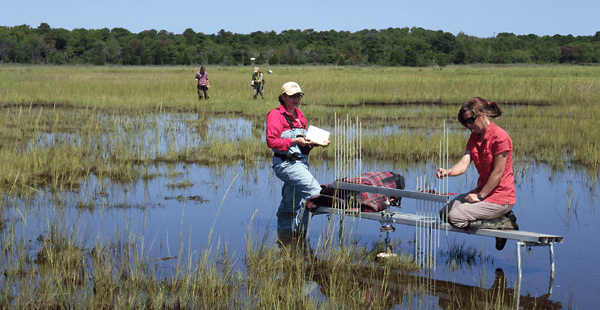Drexel Scientist Studies Hurricane Sandy Impact on NJ Coastal Wetlands One Year Later
 By Rachel Ewing
By Rachel Ewing

- Drexel Selects New, World-Class Life Sciences Building at 3201 Cuthbert Street for Medical Research Operations
- Turn Happy Places and Memories into a Happy New Year
- Breakthrough on Gene Therapy for Hereditary Spastic Paraplegia
- Drexel Environmental Collaboratory Releases Cross-Sector Findings on Severe Weather Recovery Challenges

Hurricane Sandy landed right on top of Dr. Tracy Quirk’s wetland monitoring stations – but it wasn’t all bad news.
Quirk, an assistant professor in the Department of Biodiversity, Earth and Environmental Science at Drexel University, had been performing wetland research for several years at monitoring sites in Barnegat and Delaware Bays in New Jersey. Recording devices installed at these sites continuously measured water level and salinity for a wide range of wetland studies at Drexel and the Academy of Natural Sciences of Drexel University.
As Sandy hit and water levels rose, those measurements continued.
“We have continuous data on how long these areas were flooded and how high the water rose at these sites,” said Quirk.
It was a stroke of good luck to have captured detailed measurements during a storm of this rare magnitude. Quirk recognized that the data could provide new answers to the questions she had been investigating about how wetland ecosystems sustain themselves and function. Now she could also learn how marshes responded to the severe disturbance effect of the storm.
“The prospect of future storms of this magnitude suggests that we will need to understand their effects on ecosystem dynamics as part of the ‘new normal,’” Quirk said.
In February she began working on an intensive year-long project, funded by the National Science Foundation, to evaluate ecosystem processes in New Jersey’s salt marshes before, during, and for a year following Hurricane Sandy. Quirk is beginning to analyze findings from the study now.
Good News/Bad News: Coastal Marshes Protective from Worse Flooding, But Findings Suggest They’re Diminishing and Sinking
There was some good news from the marshes: Although some water-level recorders were over-topped and stopped recording (making it difficult to use direct measures of the water height), there was evidence of marsh swelling during the storm. That swelling is an indication of marshes’ ability to absorb some of the storm surge – which, in hard-hit urban areas, had resulted in high water marks up to seven feet during Hurricane Sandy. Quirk points out that resilient, healthy wetlands near coastal areas have a key role in protecting local communities from hurricane-induced storm surges and flooding.
“Imagine having a marsh in front of your house instead of concrete,” Quirk said. “Paved areas make flooding worse because water has nowhere to go.”
“Imagine having a marsh in front of your house instead of concrete,” Quirk said. “Paved areas make flooding worse because water has nowhere to go.”
In her post-Sandy research, Quirk was interested in finding out whether the storm affected how the marshes sustain themselves. The disturbance of an intense storm could alter the delicate equilibrium between flooding, vegetation growth and sediment deposits in wetland ecosystems – either temporarily or long-term.
That’s where the bad news comes in. As she works through the data analysis this fall, Quirk said she hasn’t found much sign of sediment deposits, before or after the hurricane struck. Sandy had the potential to deposit a lot of sediments, fast, which would have been good for building up wetlands. Hurricane Irene in 2011 had been associated with a bump up in wetland accretion by several millimeters at a number of locations in the region – a bonus growth equivalent to the amount that typically accrues in an entire year.
“Sediment-limited systems like coastal lagoon marshes largely depend on deposition by storms to vertically adjust elevation, so they don’t sink relative to sea level,” Quirk said. “In places where we have ongoing monitoring, the evidence suggests that some sites are subsiding – sinking below the surface – rather than increasing elevation at a rate similar to local sea level rise. Surface deposition would be a good thing for these marshes.”
Any number of reasons could explain why those hoped-for sediment deposits didn’t materialize, she said. Maybe the unusually high tide during Hurricane Sandy caused less suspension of sediments in the storm-surge waters. Or maybe the storm water did carry sediments and plant debris, but dropped them on the barrier island or inland along the tree line and not at her sampling sites in the marsh interior.
Essential to Protect Coastal Marshes from Subsiding into Water
Whatever the reason, Quirk’s findings point to cause for continued concern over the coastal marshes’ future.
Whatever the reason, Quirk’s findings point to cause for continued concern over the coastal marshes’ future.
“These salt marshes provide a number of extremely valuable ecosystem services and benefits to society,” she said. Storm surge protection is just one of these. Coastal marshes also provide excellent habitat for commercially and recreationally important fish and shellfish, especially as a nursery ground for these animals. They’re also important for storing, transforming and removing nutrients that can be harmful to the aquatic ecosystems.
The areas of tidal wetlands remaining in New Jersey have been sharply reduced in proportion to the past, with surrounding areas built up with bulkheads and other development – making the remaining wetlands all the more crucial to protect because they cannot shift inland.
“With accelerating sea level rise, it is unknown how many of these marshes are going to be able to keep up because they are dependent on plant growth, which is a slow process,” Quirk said.
“Since 2010, the northern area of Barnegat Bay and the marsh on the bayside of the barrier island at Island Beach State Park is converting before our eyes from marsh to open water.”
An earlier version of this article ran in EXEL 2013, Drexel University’s research magazine.
Drexel News is produced by
University Marketing and Communications.